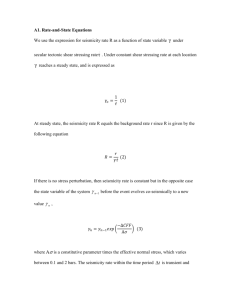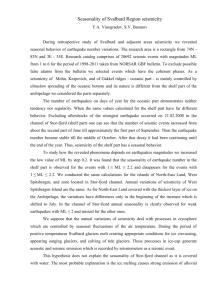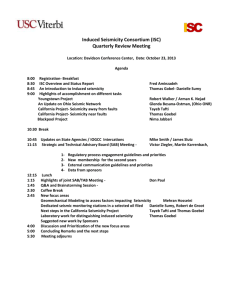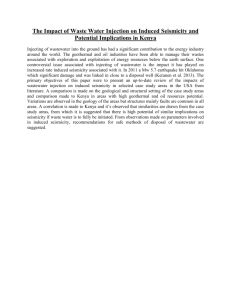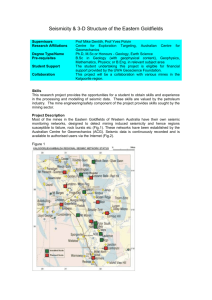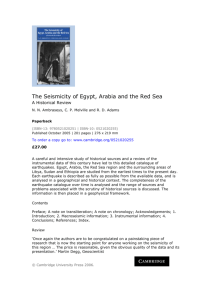code related issues in seismic design of buildings in korea
advertisement
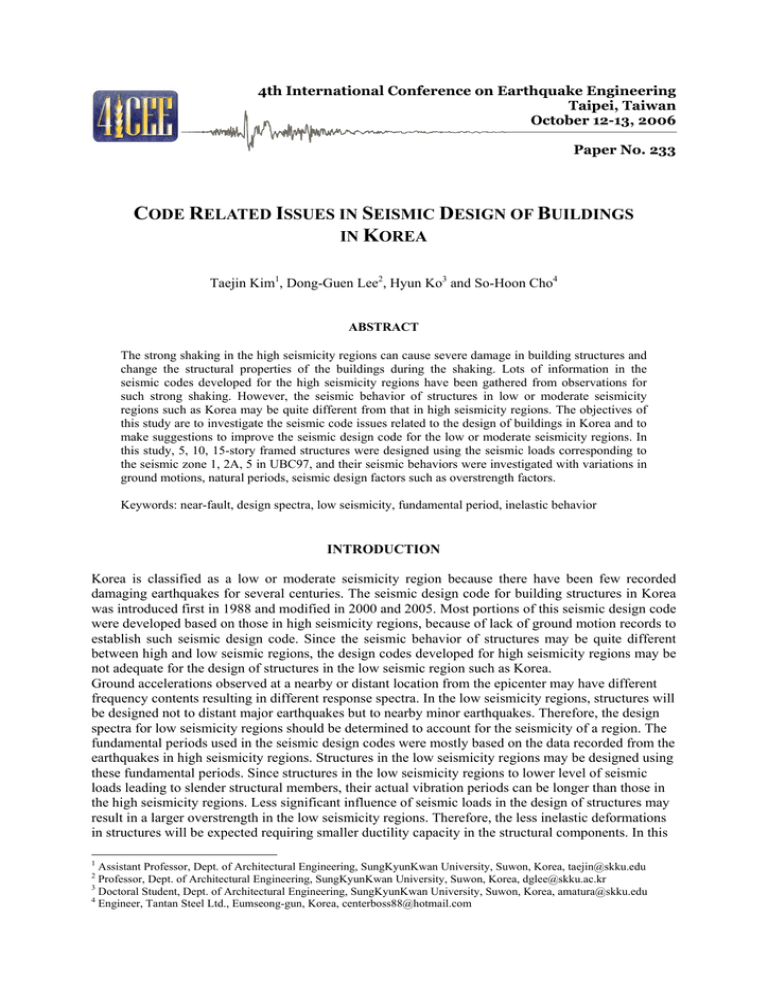
4th International Conference on Earthquake Engineering Taipei, Taiwan October 12-13, 2006 Paper No. 233 CODE RELATED ISSUES IN SEISMIC DESIGN OF BUILDINGS IN KOREA Taejin Kim1, Dong-Guen Lee2, Hyun Ko3 and So-Hoon Cho4 ABSTRACT The strong shaking in the high seismicity regions can cause severe damage in building structures and change the structural properties of the buildings during the shaking. Lots of information in the seismic codes developed for the high seismicity regions have been gathered from observations for such strong shaking. However, the seismic behavior of structures in low or moderate seismicity regions such as Korea may be quite different from that in high seismicity regions. The objectives of this study are to investigate the seismic code issues related to the design of buildings in Korea and to make suggestions to improve the seismic design code for the low or moderate seismicity regions. In this study, 5, 10, 15-story framed structures were designed using the seismic loads corresponding to the seismic zone 1, 2A, 5 in UBC97, and their seismic behaviors were investigated with variations in ground motions, natural periods, seismic design factors such as overstrength factors. Keywords: near-fault, design spectra, low seismicity, fundamental period, inelastic behavior INTRODUCTION Korea is classified as a low or moderate seismicity region because there have been few recorded damaging earthquakes for several centuries. The seismic design code for building structures in Korea was introduced first in 1988 and modified in 2000 and 2005. Most portions of this seismic design code were developed based on those in high seismicity regions, because of lack of ground motion records to establish such seismic design code. Since the seismic behavior of structures may be quite different between high and low seismic regions, the design codes developed for high seismicity regions may be not adequate for the design of structures in the low seismic region such as Korea. Ground accelerations observed at a nearby or distant location from the epicenter may have different frequency contents resulting in different response spectra. In the low seismicity regions, structures will be designed not to distant major earthquakes but to nearby minor earthquakes. Therefore, the design spectra for low seismicity regions should be determined to account for the seismicity of a region. The fundamental periods used in the seismic design codes were mostly based on the data recorded from the earthquakes in high seismicity regions. Structures in the low seismicity regions may be designed using these fundamental periods. Since structures in the low seismicity regions to lower level of seismic loads leading to slender structural members, their actual vibration periods can be longer than those in the high seismicity regions. Less significant influence of seismic loads in the design of structures may result in a larger overstrength in the low seismicity regions. Therefore, the less inelastic deformations in structures will be expected requiring smaller ductility capacity in the structural components. In this 1 Assistant Professor, Dept. of Architectural Engineering, SungKyunKwan University, Suwon, Korea, taejin@skku.edu Professor, Dept. of Architectural Engineering, SungKyunKwan University, Suwon, Korea, dglee@skku.ac.kr 3 Doctoral Student, Dept. of Architectural Engineering, SungKyunKwan University, Suwon, Korea, amatura@skku.edu 4 Engineer, Tantan Steel Ltd., Eumseong-gun, Korea, centerboss88@hotmail.com 2 study it was investigated to verify the adequacy of current seismic design codes in low seismicity regions, the ground motion and design spectra, the fundamental periods, and the inelastic behavior for structures in low seismicity regions. For this purpose, 5, 10 and 15-story example structures were designed to UBC97 (ICBO, 1997) and inelastic static and dynamic analyses are performed to estimate seismic behavior of the structures. GROUDN MOTION AND DESIGN SPECTRUM The main target of seismic design of structures in low or moderate seismicity regions is to resist minor or moderate earthquakes occurring near the site, not to resist distant major earthquakes because the probability of having such event is quite low. Therefore, the ground motion to be used in the seismic design should be determined based on the near-fault earthquake records which may have somewhat different characteristics from far-fault records. Table 1. Near-fault earthquake records (Mavroeidis et al. 2004) No. Earthquake 1 Parkfield 1966/06/28 2 3 4 5 6 7 8 9 10 11 12 San Fernando 1971/02/09 Gazli, USSR 1976/05/17 Tabas, Iran 1978/09/16 Coyote Lake 1979/08/06 Imperial Valley 1979/10/15 Imperial Valley Imperial Valley Imperial Valley Morgan Hill 1984/04/24 Superstitn Hills(B) 1987/11/24 Station Closest Magnitude Fault Fault Type Record/Component Distance (Mw) (km) 1013 Cholame #2 PARKF/C02065 6.20 0.1 Strike-Slip 279 Pacoima Dam SFERN/PCD164 6.55 3.0 Reverse 9201 Karakyr GAZLI/GAZ000 6.80 3.0 Reverse 9101 Tabas TABAS/TAB-TR 7.11 1.2 Reverse 57383 Gilroy Array #6 COYOTELK/G06230 5.63 1.2 Strike-Slip 955 El Centro Array #4 IMPVALL/H-E04230 952 El Centro Array #5 IMPVALL/H-E05230 942 El Centro Array #6 IMPVALL/H-E06230 5028 El Centro Array #7 IMPVALL/H-E07230 57191 Halls Valley MORGAN/HVR240 6.0 6.50 2.7 0.3 1.8 Strike-Slip 6.37 3.0 Strike-Slip 5051 Parachute Test Site SUPERST/B-PTS225 01335 El Centro Imp. Co. SUPERST/B-ICC000 Superstitn Hills(B) Cent Loma Prieta 16 LGPC LOMAP/LGP000 1989/10/18 58065 Saratoga - Aloha LOMAP/STG090 Loma Prieta Ave Erzincan, Turkey 95 Erzincan ERZIKAN/ERZ-NS 1992/03/13 Landers 1992/06/28 24 Lucerne LANDERS/LCN275 Northridge 0655 Jensen Filter Plant NORTHR/JEN022 1994/01/17 Northridge 77 Rinaldi Receiving Sta NORTHR/RRS228 Northridge 74 Sylmar - Converter Sta NORTHR/SCS052 90056 Newhall - W. Pico NORTHR/WPI046 Northridge Canyon Rd. 0.7 6.40 Strike-Slip 13.6 3.0 6.90 Oblique 8.3 6.63 2.0 Strike-Slip 7.20 1.1 Strike-Slip 5.2 6.70 6.0 5.1 5.3 Reverse Twelve earthquake records listed in Table 1 are used to investigate the difference in the acceleration response spectrum of near-fault earthquakes from the design response spectrum defined in the seismic design code, UBC-97 in this study. Fig. 1 shows acceleration response spectrums using the earthquake records. All of the records are scaled to have PGA of 1.0g for the purpose of comparison. The solid line in Fig. 1(a) shows an average spectral acceleration by earthquakes of magnitude greater than Mw = 6.5 which may represent events in high seismicity regions, while the solid line in Fig. 1(b) shows an average spectral acceleration by the ground motion in moderate seismicity regions. 5 Spectral Acceleration(g) Spectral Acceleration(g) 5 4 3 2 1 0 4 3 2 1 0 0 1 2 3 4 5 0 1 2 Period(sec) 3 4 5 Period(sec) (a) High Seismicity Regions (b) Moderate Seismicity Regions Figure 1. Acceleration spectrum of near-fault earthquakes Fig. 2 shows plots of average acceleration response spectrum versus design response spectrum for both in high seismicity regions and moderate seismicity regions. Near source factors were considered in high seismic regions while they were not considered in moderate seismic regions. Fig. 2(b) implies significant underestimation of spectral acceleration in the longer period range. Therefore, it can be recommended to use a design response spectrum that can account for this observation in the seismic design in low or moderate seismicity regions. In many cases, the soil condition of the construction sites may be classified as SA or SB in Korea leading to larger seismic loads for lower structures. However, significant earthquake damages can be expected in mid- or high-rise building structures designed to current design code based on the observations from Fig. 2(b). 2.5 1 UBC-97 Zone-2B_SB Average Spectral Acceleration(g) Spectral Acceleration(g) UBC-97 Zone-4_SB Average 2 1.5 1 0.5 0 0.8 0.6 0.4 0.2 0 0 1 2 3 4 Period(sec) (a) High Seismicity Regions 5 0 1 2 3 4 Period(sec) (b) Moderate Seismicity Regions Figure 2. Design spectrum versus average spectrum 5 EXAMPLE BUILDINGS Example buildings used in this study are 5-, 10- and 15-stories reinforced concrete framed structures. Example buildings have the same plan as shown in Fig. 3(a) and the elevation of example structures are illustrated in Fig. 3(b)-(d). Design wind loads may be larger in y-direction since the structures have a rectangular plan while seismic loads may be the same in both directions. Therefore, seismic loads would have larger influence in x-direction on the design of example buildings. Y2 Y1 Y4 Y3 Y5 Y6 6m 6m 6m 6m 6m G2 C4 G2 C3 G2 C3 G2 C3 G2 C3 5.4m 9m C4 (a) Plan y 4@3.9m 9m X2 C2 G4 G2 C3 X3 (b) Elavation of the 5-story building Y1 x Y1 Y2 Y3 Y4 Y5 Y6 6m 6m 6m 6m 6m X1 C4 G4 G1 C1 G3 G2 C3 G3 G2 C3 G1 C1 G3 G2 C3 G3 G3 G4 G2 C4 G1 C1 G3 G1 C1 G3 G3 G4 G1 C2 Y1 Y4 Y2 Y3 Y5 Y6 6m 6m 6m 6m 6m Y5 Y6 Y3 Y4 Y2 6m 6m 6m 6m 6m 14@3.9m 9@3.9m 5.4m 5.4m (c) Elavation of the 10-story building (d) Elavation of the 15-story building Figure 3. Plan and elevation of the example building structures Example building structures were designed with dead loads and live loads of 650kgf/cm2 and 250kgf/cm2, respectively. Wind loads and seismic loads are determined according to UBC 97. The basic wind speed of 70mph was assumed to determine wind loads. The soil profile type was assumed to be SB and the importance factor of 1.0 was used to determine seismic loads. Example structures with 5, 10 and 15 stories are designed for seismic zones 1, 2B and 4 to investigate inelastic response of building in low (LSR), moderate (MSR) and high (HSR) seismicity regions using the modification factors of 3.5, 5.5 and 8.5 for three levels of ductility capacity such as OMRF, IMRF and SMRF. The use of OMRF is prohibited in seismic zones 2A, 2B, 3 and 4 and IMRF is not allowed in seismic zones 3 and 4 in UBC97. Therefore, structures with 5, 10 and 15 stories are designed for 6 different seismic loads. The design of example structures was performed by 3 leading engineering companies in Korea to account for the engineering practice. FUNDAMENTAL PERIODS OF STRUCTURES Fundamental periods of vibration of 18 example structures designed by each company are obtained from numerical analysis and the results of one company is presented in Table 2. These periods seem to be quite longer than expected because the effects of floor slabs and nonstructural components are not included in the analysis. However, the difference in the stiffness of frames according to the seismicity can be noticed in this table. OMRF R=3.5 HSR x-dir MSR LSR 1.4810 HSR y-dir MSR LSR 1.5568 Table 2. Periods of example structures 5-story 10-story IMRF SMRF OMRF IMRF SMRF R=5.5 R=8.5 R=3.5 R=5.5 R=8.5 1.2126 2.0488 1.4543 1.4810 2.3222 2.3222 1.4810 1.4810 2.3222 2.3222 2.3222 1.2846 1.9090 1.5300 1.5568 2.4568 2.4568 1.5568 1.5568 2.4568 2.4568 2.4568 OMRF R=3.5 2.8219 2.9903 15-story IMRF R=5.5 2.8219 2.8219 2.9903 2.9903 SMRF R=8.5 2.5194 2.8219 2.8219 2.3549 2.9903 2.9903 The periods of the SMRF example structures shown in Fig. 4 were normalized using the periods of the buildings designed for high seismicity regions. As shown in this figure the periods in low seismicity regions were ranged between 1.1 and 1.3 times those in high regions. Although the fundamental periods for both regions was identical following the code, structures in the low seismicity regions were designed using lower level of seismic loads. Therefore members of the structures in low seismicity region can be slender than those in high seismicity region, leading to longer periods. 2.0 1.0 5 story 10 story 15 story 0.0 Normalized Period Normalized Period 2.0 1.0 5 story 10 story 15 story 0.0 HSR 5 MSR 10 Seismicity (a) x-direction LSR 15 HSR 5 MSR 10 LSR 15 Seismicity (b) y-direction Figure 4. Normalized Period of SMRF example structures In addition to this issue, the structural systems used in low seismicity regions may be different from those of high seismicity regions. The most popular structural system used for the construction of highrise apartment buildings in Korea is the box system which consists of floor slabs and shear walls without complete 3D moment resisting frames and flat plate system is getting popular recently. The difference in the structural system requires adequate estimation of fundamental period of structures for seismic design of such structures because mid- or high-rise building structures may be subjected to seismic loads larger than expected based on current seismic design code. INELASTIC BEHAVIOR OF STRUCTURES Overstrength and system ductility can be estimated from the force-displacement relationship of structures to evaluate response modification factors for example structures. For this purpose, a computer code MIDAS-GEN was used to perform 3-dimensional pushover analysis. Response Modification Factor The relationship between force and displacement for a structure subjected to lateral loads is shown in Fig. 5. The structure was designed to resist the design base shear VD and the corresponding displacement or design displacement is uD. As the lateral load is increased, the structure will undergo inelastic deformation and the force-displacement relationship is plotted as a thick solid curve which can be simplified as the bilinear relationship represented by the thick dashed line in Fig. 5 from which the yield base shear (Vy) and yield displacement (uy) can be determined. Overstrength of a structure is defined dividing Vy by VD as follows (Lee et al., 1990): RΩ = Vy (1) VD Overstrength of a structure is introduced by factors such as the load factor and reduction factor used in the design as well as the presence of gravity loads and wind loads. Force Vy VD uD uy um Displ. Figure 5. Force-displacement relationship of a structure subjected to lateral forces The ductility factor of a structural system can be determined based on the ductility capacity of structures defined as the ratio of the maximum displacement um to the design displacement uD as follows: Rμ = um uy (2) Most of the seismic design codes are using the response modification factor determined by multiplying the ductility factor to the overstrength factor for the reduction of seismic loads in the design of structures. Overstrength Factor Three dimensional pushover analysis was performed to estimate the overstrength of example structures designed by 3 engineering companies and average of overstrength is shown in Table 3. Dir. Seismicity high moderate low high moderate low x y Table 3. Average of overstrength for example structures 5-story 10-story 15-story OMRF IMRF SMRF OMRF IMRF SMRF OMRF IMRF SMRF R=3.5 R=5.5 R=8.5 R=3.5 R=5.5 R=8.5 R=3.5 R=5.5 R=8.5 2.13 2.10 2.33 2.61 3.92 2.20 2.74 2.05 2.37 3.87 6.19 9.64 3.25 4.92 6.65 3.17 4.51 5.30 2.86 2.80 2.89 3.41 4.71 3.70 4.29 3.41 4.07 4.59 7.13 11.17 4.93 7.65 9.79 5.17 7.13 10.01 Overstrength factors of structures in low, moderate and high seismicity regions designed with the response modification factor of 8.5 are shown in Fig. 6. Overstrength factors in low seismicity regions turned out to be much larger than those of high seismicity regions as could be expected from Eq. (1). The difference in overstrength factors is more significant in 5-stories structures for which the effect of seismic loads less significant because the effect of gravity loads is dominant. As the number of stories increases, wind loads are increased accordingly reducing the effect of seismic loads in the design resulting in increased overstrength. Overstrength in y-direction is larger for the same reason. Overstrength factors are close to each other ranging from 2.10 to 2.89 for structures in high seismicity regions because the design may be governed by seismic loads. However, in low seismicity regions, overstrength factors are increased ranging from 5.30 to 11.17. MSR LSR HSR Overstrength Factor (RΩ) Overstrength Factor (RΩ) HSR 12.0 11.0 10.0 9.0 8.0 7.0 6.0 5.0 4.0 3.0 2.0 1.0 5 10 MSR LSR 12.0 11.0 10.0 9.0 8.0 7.0 6.0 5.0 4.0 3.0 2.0 1.0 15 5 10 Story 15 Story (a) x-direction (b) y-direction 12.0 11.0 10.0 9.0 8.0 7.0 6.0 5.0 4.0 3.0 2.0 1.0 Overstrength Factor (RΩ) Overstrength Factor (RΩ) Figure 6. Overstrength factor of SMRF example structures 5 story 10 story 15 story 3 4 5 6 7 8 9 12.0 11.0 10.0 9.0 8.0 7.0 6.0 5.0 4.0 3.0 2.0 1.0 5 story 10 story 15 story 3 4 5 6 7 8 Response Modification Factor (R) Response Modification Factor (R) (a) x-direction (b) y-direction Figure 7. Overstrength factor in low seismicity regions 9 Overstrength factors of structures in low seismicity regions designed with the response modification factors of 3.5, 5.5 and 8.5 are shown in Fig. 7. It can be noticed that overstrength factors are larger for larger response modification factors which reduces the effect of seismic loads in the design. In low seismicity regions, overstrength factors are close to each other when the response modification factor is 3.5 and the difference in overstrength factors is increased significantly for larger response modification factors. System Ductility Demand The system level ductility demand calculated by dividing the response modification factor by the overstrength of the example structures is listed in Table 4. Dir. x y Seismicity high moderate low high moderate low Table 4 System ductility demand for example structures 5 story 10 story 15 story OMRF IMRF SMRF OMRF IMRF SMRF OMRF IMRF SMRF R=3.5 R=5.5 R=8.5 R=3.5 R=5.5 R=8.5 R=3.5 R=5.5 R=8.5 3.99 4.05 3.65 2.11 2.17 2.50 3.10 2.68 3.59 1.00 1.00 1.00 1.08 1.12 1.28 1.10 1.22 1.60 2.97 3.04 2.94 1.61 1.80 1.49 1.98 1.61 2.09 1.00 1.00 1.00 1.00 1.00 1.00 1.00 1.00 1.00 Fig. 8 shows ductility demands for structures in low, moderate and high seismicity regions designed with the response modification factor of 8.5. Ductility demands for structures in low seismicity regions turned out to be significantly smaller when those in higher seismicity regions. Therefore, structural details for structures in low seismicity regions may not be required to have the ductility capacity corresponding to the response modification factor in high seismicity regions. MSR LSR System Ductility Factor (Rμ) System Ductility Factor (Rμ) HSR 6.0 5.0 4.0 3.0 2.0 1.0 HSR 6.0 MSR LSR 5.0 4.0 3.0 2.0 1.0 0.0 0.0 5 10 15 5 10 15 Story Story (a) x-direction (b) y-direction Figure 8. System ductility factor of SMRF example structures CONCLUSIONS Seismic design of structures in low or moderate seismicity regions will be somewhat different from that in high seismicity regions because some factors such as the ground motions and vibration periods, overstrength and ductility capacity of structures would be influenced by the seismicity. Overstrength factors and ductility demands for building structures designed in low and high seismicity regions were obtained from 3-dimensional pushover analysis and 2-dimensional dynamic analysis, in this study, to investigate response modification factors and corresponding structural details in low seismicity regions. Some of the main conclusions are as follows: 1. Design response spectrum for the low or moderate seismicity regions should be determined with emphasis on the near-fault earthquake records. 2. Vibration of periods of structures may be longer in low seismicity regions because of the lower stiffness of structural elements resulted by the lower seismic loads. 3. Overstrength factors in low seismicity regions are larger than those of high seismicity regions for structures designed with the same response modification factor. Therefore, ductility demand in low seismicity regions turned out to be much smaller than those for high seismicity regions. ACKNOWLEDGMENTS This research (03R&D C04-01) was financially supported by the Ministry of Construction & Transportation of South Korea and Korea Institute of Construction and Transportation Technology Evaluation and Planning, and the authors are grateful to the authorities for their support. The authors are grateful for their support. REFERENCES International Conference of Building Officials (1997). Uniform Building Code, Whitter, California. Mavroeidis, G. P., Dong, G., Papageorgiou, A. S. (2004). “Near-fault ground motions, and the response of elastic and inelastic single-degree-of-freedom (SDOF) systems”, Earthquake Engineering and Structural Dynamics, 1023-1049. Lee, D-G. , Song, J-K., Yun, C-B. (1990). “Estimation of System-level Ductility Demands for Multi-story Structures”, Engineering Structures, 19(12), 1025-1035.
